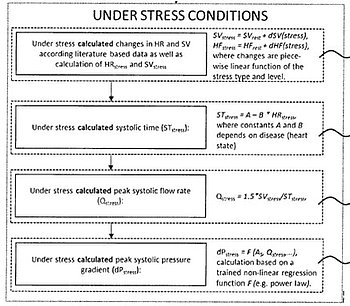Non-invasive pressure gradient prediction for a cardiovascular narrowing
Keywords
Coarctation, pressure drop, pressure gradient, aortic stenosis, non- invasive prediction, cardiovascular narrowing
Invention Novelty
This non-invasive method allows the determination of pressure gradients at a cardiovascular narrowing like coarctation or stenotic heart valve and can even predict the pressure drop that might occur under stress conditions without the need to induce stress situations through physical exercises or adrenergic drug infusion. The method is based on mathematical models acquired from clinical data and does not require complex fluid simulations of the blood flow.
Value Proposition
As a consequence of clinical practice guidelines there is a high clinical need for the accurate measurement of the pressure gradient at a stenosis, ideally in a non-invasive manner. Of special interest is the pressure drop at a cardiovascular narrowing of a patient under stress conditions. Current non-invasive methods like special MRI techniques or Doppler echocardiography are unsatisfactory due to low resolution or overestimated values. Furthermore, current assessment of stress pressure gradients involve cardiac stress response induced by exercise or drug stimulations. However, there are many limitations for the stress test including, for example, acute myocardial infarction within 48 hours, unstable angina, severe symptomatic aortic stenosis, uncontrolled hypertension and others. The innovative non-invasive method for pressure gradient determination in rest and prediction for stress conditions addresses all these limitations and leads to a more safe, precise and patient friendly diagnosis.For the pressure gradient prediction of a stenosis the following parameters are acquired under rest conditions: The degree of stenosis is assessed with an imaging acquisition system. Furthermore, the flow profile of the stenosis is assessed by characterizing peak systolic flow rate, heart rate, stroke volume and systolic time. With these parameters the pressure gradient under rest is predicted using a fit function based on a collected clinical dataset. Considering the changes of the heart rate, systolic time and stroke volume depending on the kind and level of stress, the same data fitting approach allows to predict the pressure gradient under stress conditions.
Technology Description
For the pressure gradient prediction of a stenosis the following parameters are acquired under rest conditions: The degree of stenosis is assessed with an imaging acquisition system. Furthermore, the flow profile of the stenosis is assessed by characterizing peak systolic flow rate, heart rate, stroke volume and systolic time. With these parameters the pressure gradient under rest is predicted using a fit function based on a collected clinical dataset. Considering the changes of the heart rate, systolic time and stroke volume depending on the kind and level of stress, the same data fitting approach allows to predict the pressure gradient under stress conditions.
Commercial Opportunity
The technology is available for in-licensing.
Development Status
The proof of concept has been shown.
Patent Situation
A patent application is pending in DE.
Further Reading
Franke, B., Weese, J., Waechter-Stehle, I. et al. Towards improving the accuracy of aortic transvalvular pressure gradients: rethinking Bernoulli. Med Biol Eng Comput 58, 1667–1679 (2020). https://doi.org/10.1007/s11517-020-02186-w.
Thamsen B., Yevtushenko P., Gundelwein L., Lamecker H., Kühne T., Goubergrits L. (2020). Unsupervised Learning and Statistical Shape Modeling of the Morphometry and Hemodynamics of Coarctation of the Aorta. In: Martel A.L. et al. (eds) Medical Image Computing and Computer Assisted Intervention – MICCAI 2020. MICCAI 2020. Lecture Notes in Computer Science, vol 12264. Springer, Cham. https://doi.org/10.1007/978-3-030-59719-1_75.




